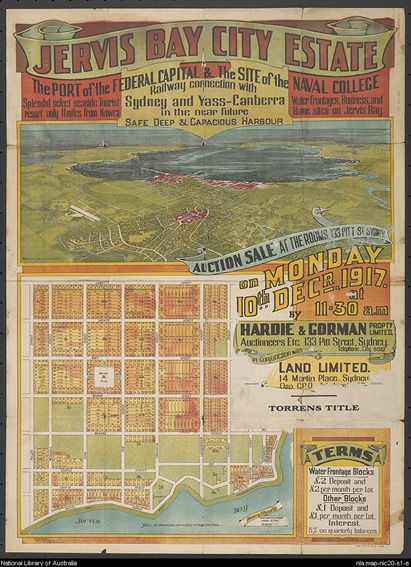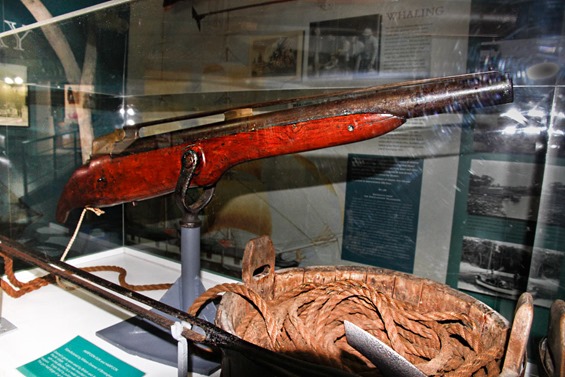| I used lights to illuminate the old lighthouse ruins. I hope I didn’t disturb the ghosts to much. |
 |
 |
30 March 2016
A fond farewell
29 March 2016
Whaling Jervis Bay
23 March 2016
22 March 2016
1832. Jervis Bay. A sudden and awful death.
21 March 2016
A bit of wishfull thinking.
| Despite all the publicity and grand ideas, as far back as 1917 by specualtive land developers such as Henry. F. Halloran, Jervis Bay was still a sleepy little bay in 1924, with few permanent inhabitatants. Timber and shipbuilding were the main employers, tourism was just starting to become an important part of the bay’s development. |
 |
| Investors were drawn to these schemes, many lost their investment over time, much of the land was aquired by the local Shoalhaven Council through acquisition from rates arrears. This advertisement appeared in a Sydney Newspaper in 1924, and didn’t go down to well with the correspondent of the Catholic Press. |
 |
| The museum has a wonderful exhibition with large maps and information about the Grand Visions” it’s a real eye opener to what could have been. |
17 March 2016
Lady Denman.
Lady Denman
15 March 2016
Museum Visitors
| The museum is located in a very unique location and has a beautiful fish pond right at it’s front door, this has created a fantastic habitat for local birds and wildlife. |
 |
 |
 |
Early light.
10 March 2016
S.S Chimborazo ran headlong into Point Perpendicular.
| Morning mist |
| Below this post there are some pictures of a dense fog taken on the 8th of March 2016. At 5.30 am the bay was very clear, the water was as smooth as glass, with a very slight almost undetectable offshore breeze, |
| S.S Chimborazo |
 |
| 138 years ago on March 14th 1878 the grand steamer S.S Chimborazo was passing Jervis Bay Under the command of Captain John Vine Hall, known as a gentleman of some experience in Australian waters, she was travelling to Sydney carrying cargo and passengers. Captain Hall was hugging the coast more closely than would have been prudent in such a large vessel. At a quarter to 10a.m. St Georges Head was observed "not far off" the port bow, the officer on deck sent word to the captain that the course the vessel was steering would bring her close to land. Captain Hall merely altered her course to be N. by E. which would cause the vessel to go a little more to eastward than she would otherwise had done. A second message was sent about seven or eight minutes later, to the effect that the ship was close to land, and that the officer on watch had hauled out. This bought the captain on deck, he found the ships heading to be N.E. by compass, with a deviation of two points E. he saw Cape St George not very far distant; and when he was asked by the second officer whether he should keep the vessel's course up the coast his reply was - "No keep her as she is going at present." all this time her speed was 12 knots an hour. It's important to remember the sailing rules of the mercantile marine direct that when in fog the whistle should be sounded and the speed slackened, the Chimborazo was going ahead at full speed despite being in a heavy mist.. |
 |
| "Breakers ahead!" |
| Suddenly the alarm was given by the look-out on the forecastle in a tone bespeaking terrified earnestness "breakers ahead". There was no possibility of averting the danger, quickly responding to orders the machinery was promptly stopped in it's action, but then quickly followed the crash, which was severe enough to throw passengers off their feet. There was a rush of passengers to the deck, and before many moments had passed the shock explained the meaning of the sudden stoppage. There was intense excitement and confusion particularly amongst the ladies. The whole of the ships crew came swiftly into action, and the steady and quick way in which orders were attended to spoke of the excellent nautical discipline. The first order was to swing the ship's boats out in their tackles ready for lowering if the worst fears were realised, and simultaneously guns were fired to inform the lighthouse - keeper of their distress. The water was found rising forward of the collision bulk heads, and then in the forward compartments, but none had made it's way into the main compartment. It was found the ship had struck the rocks on the inner side of point perpendicular, and rested with her bows on the rocks, and that round the place there was 23 to 25 fathoms of water, while on the starboard side a sunken rock was visible. 15 or 20 minutes had elapsed when efforts were made to get the ship out of her critical position; orders were given for all the passengers to run aft with a view of tilting the ship up, and the engines being A coasting ketch observing the danger, ran down and stood by the ship until she had got to an anchorage. As the ship drifted into Jervis Bay, all the passengers behaved admirably, and were soon transferred to the boats, the ladies and children being first placed in them with a supply of provisions. In about half an hour all the passengers were landed on a little beach, a few hundred yards from where the vessel struck, the sailors and others carrying the women and children through the slight surf. The Chimborazo then went to Darling Roads, a sheltered position in the southern part of Jervis Bay. The passengers re-embarked onto the A.S.N. Companies steamer Collaroy, which had been chartered by the agents, Messre. Gilchrist, Watt and Co, to take them to Sydney.  The ships bottom was examined by a diver and it was found that about 24 ft of keel from the cultivator aft, is gone; some of the garboard planking is also damaged, and there is a hole about 10 feet long in the garboard. The cargo was unloaded onto the steamer 'Corea" to lighten her, and after a few days she slowly made the rest of her voyage to Sydney, where she was shored up in the government dock at Cockatoo Island. 'The bulkhead saved the vessel." Fortunately the Chimborazo was built in compartments and, as Captain Hall laconically put's it 'the bulkhead saved the vessel."  June 14 1878 - The Chimborazo's repairs were complete and she was launched from the dock at half-past 5' o'clock in the evening in the presence of some 400 spectators, who cheered as the ship floated out into the bay.
This caused an uproar in the press of the day. The Argus Tuesday 23rd April 1878. "The punishment is ludicrously disproportionate to the offence. If the Chimborazo had gone to pieces, and the coast strewn with corpses of her passengers and crew, with her valuable cargo, and with the wreck of a noble piece of marine architecture - her master would have been legally and morally responsible for the terrible disaster, By a wonderful stroke of good fortune this calamity was averted, but the culpable negligence or temerity of Captain Hall was so great as to deserve a commensurate penalty, if only to serve as a warning to other master mariners occupying similarly responsible position. Hugging the coast. |
9 March 2016
Jervis Bay
| 8th March 2016. A spectacular strange start to the day. The air was very still and clear, there was no indication anything extrodinary was going to happen. |
 5am - the sky was clear and Point Perpendicular could be clearly seen. The last of the moon was still visable and Jupiter was the brightest star in the sky. 5am - the sky was clear and Point Perpendicular could be clearly seen. The last of the moon was still visable and Jupiter was the brightest star in the sky. |
 5.30 am - Looking back at Huskisson…the fog started to rise and was illuminated by the neighbourhood lights. 5.30 am - Looking back at Huskisson…the fog started to rise and was illuminated by the neighbourhood lights. |
 7.30 am - As the sun rose the fog started to sweet across the bay, at this stage you can still just make out Point Perpendicular – 30 minutes later you could hardly see the headland in the foreground. 7.30 am - As the sun rose the fog started to sweet across the bay, at this stage you can still just make out Point Perpendicular – 30 minutes later you could hardly see the headland in the foreground. |
 8.00 am – Point Perpendicular had disappeared, the sun was a strange dull glow. nearly all the colour had disappeared creating an almost black and white world. 8.00 am – Point Perpendicular had disappeared, the sun was a strange dull glow. nearly all the colour had disappeared creating an almost black and white world. |
 |
| 9.am - Currambene Creek looked particuarly beautiful. |
3 March 2016
Sussex Inlet.
2 March 2016
Jervis Bay – Lithograph
| This rare and beautiful lithograph of Jervis Bay with Plantation Point in the middle ground was by Captain Robert Westmacott, the image was printed on stone at William Spreat’s Establishment. believed to be from 1848. |
 |
| The title accompanying the image – Drawn from nature by Captain Westmacott. |
Captain Robert Marsh Westmacott. 1801 - 1870
Sketcher, army officer and pioneer, is best known for his Sketches in Australia, a volume of eighteen tinted lithographic views each preceded by a short description of the locality pictured and some historical background. |
| ref: https://www.uow.edu.au/~morgan/rmw1.html |
 |












